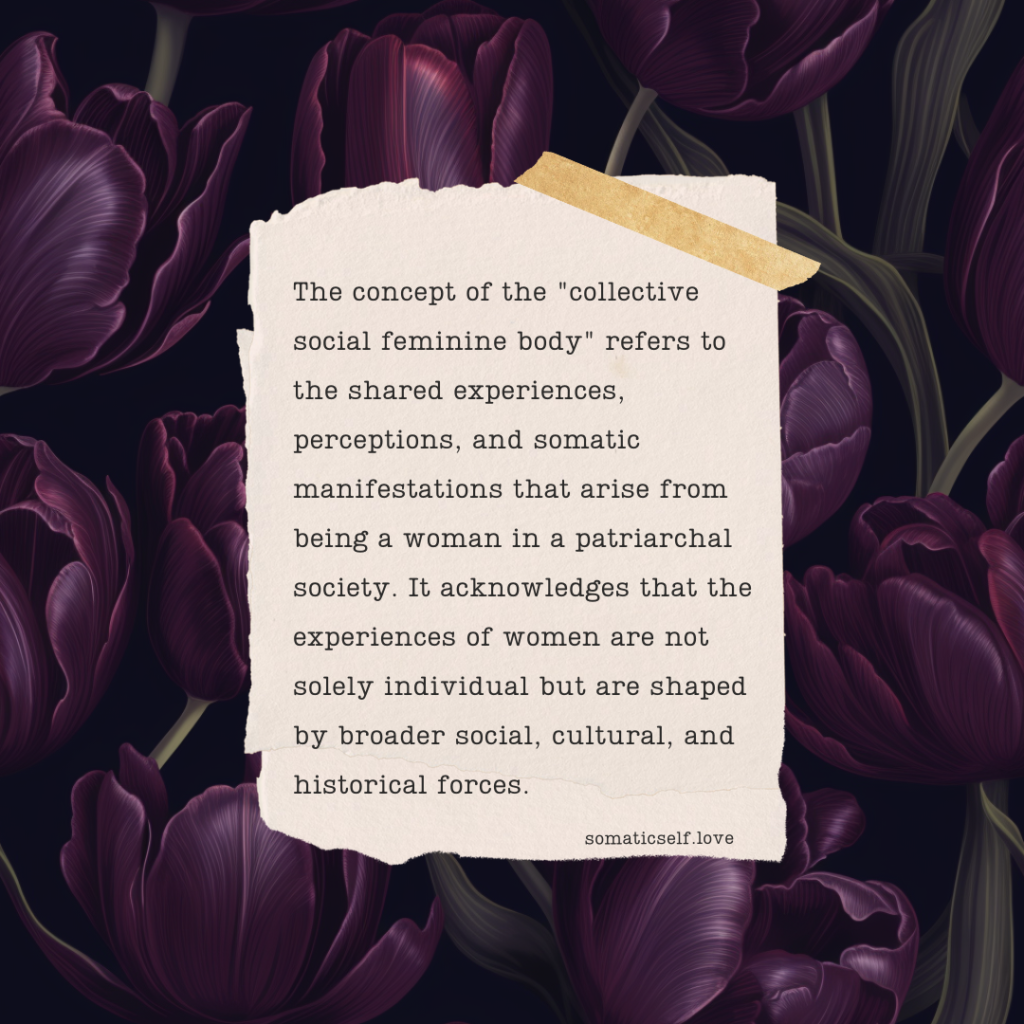Collective Social Feminine Body

The concept of the “collective social feminine body” refers to the shared experiences, perceptions, and somatic manifestations that arise from being a woman in a patriarchal society. It acknowledges that the experiences of women are not solely individual but are shaped by broader social, cultural, and historical forces.
The collective social feminine body encompasses both the physical and embodied aspects of being a woman within the context of the patriarchy. It recognizes that women’s bodies and experiences are influenced by societal norms, expectations, and power dynamics that perpetuate gender inequality and oppression.

In this context, the collective social feminine body refers to the ways in which societal structures and norms shape women’s experiences, perceptions, and relationships with their bodies. It includes the internalization of societal messages about femininity, beauty standards, body image issues, expectations around behavior and roles, and the somatic responses that arise from navigating these pressures.
The collective social feminine body acknowledges that women often share similar challenges and traumas as a result of living within a patriarchal system. This can manifest as experiences of objectification, discrimination, violence, body shame, limited agency, and internalized misogyny. These experiences are not isolated but part of a broader pattern that affects women across different cultural, racial, and socioeconomic contexts.
Understanding the collective social feminine body provides a framework for recognizing the systemic nature of gender-based oppression and the ways it impacts women’s lived experiences. By acknowledging this collective somatic shape, we can foster empathy, solidarity, and work towards dismantling oppressive systems, promoting gender equality, and creating spaces where women can fully embrace their embodied selves with freedom, authenticity, and empowerment.
Research on the Systemic Nature of Gender-Based Oppression
The following studies and articles discuss related topics, such as the systemic nature of gender-based oppression, the impact on women’s lived experiences, and the importance of understanding the collective aspects of women’s experiences:
- Crenshaw, K. (1989). Demarginalizing the Intersection of Race and Sex: A Black Feminist Critique of Antidiscrimination Doctrine, Feminist Theory and Antiracist Politics. University of Chicago Legal Forum, 140, 139-167. LinkThis seminal article by Kimberlé Crenshaw introduces the concept of intersectionality, which highlights the importance of considering multiple aspects of identity (e.g., race, gender, class) when examining oppression and discrimination. This framework is relevant to understanding the collective social feminine body and the various ways gender-based oppression can manifest.
- Connell, R. W. (1987). Gender and Power: Society, the Person, and Sexual Politics. Stanford University Press.This influential book by Raewyn Connell examines the systemic nature of gender-based oppression and the ways it impacts women’s lived experiences. The author explores the social construction of gender and how power dynamics between men and women contribute to the maintenance of gender inequality.
- Mohanty, C. T. (1988). Under Western Eyes: Feminist Scholarship and Colonial Discourses. Feminist Review, 30, 61-88. LinkChandra Talpade Mohanty’s influential article critiques Western feminist scholarship for its tendency to homogenize and essentialize the experiences of women from the Global South. This work underscores the importance of recognizing the diverse and context-specific experiences of women when examining the systemic nature of gender-based oppression.
- hooks, b. (2000). Feminist Theory: From Margin to Center. Pluto Press.In this book, bell hooks discusses the importance of centering the experiences of marginalized women and understanding the multiple systems of oppression that impact their lives. The author calls for a more inclusive feminist movement that addresses the needs and concerns of all women, regardless of race, class, or sexual orientation.
These resources provide insights into the systemic nature of gender-based oppression and the ways it intersects with other forms of discrimination. They offer a foundation for understanding the complexities of women’s lived experiences and the importance of considering the collective social feminine body when examining issues of gender inequality and social justice.